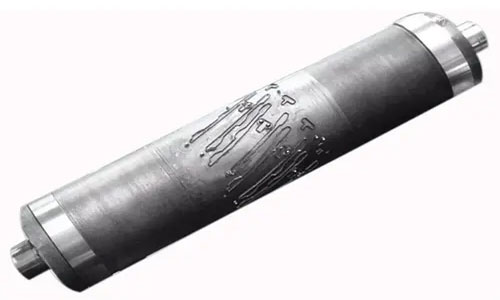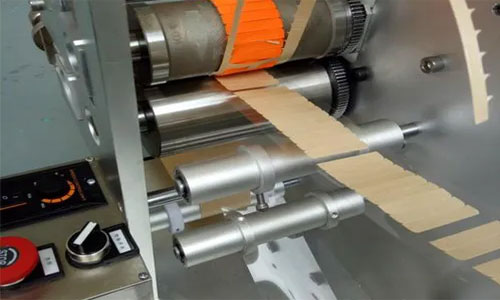Die-cutting with waste stripping is a process commonly employed by die-cutting machines to precisely cut and remove the waste material from a printed sheet. This technology enables efficient production and clean-cut finishing for various applications in the packaging and printing industry.
The die-cutting machine operates by utilizing a sharp-edged die to cut through the printed material, creating the desired shape or design. As the die presses down onto the sheet, it simultaneously removes the unnecessary surrounding material, such as excess paper or cardboard, leaving behind the finished product.
During the waste stripping process, the die-cutting machine is equipped with additional mechanisms or attachments to efficiently remove the waste material. This can include various methods such as air blasts, suction devices, or mechanical pushers. These mechanisms ensure quick and accurate removal of waste, maximizing productivity and minimizing downtime.
Die-cutting with waste stripping offers several benefits. Firstly, it enhances the quality of the final product by eliminating any unwanted or irregular edges. This results in a clean and professional appearance. Secondly, this process improves production efficiency as it eliminates the need for separate manual waste removal steps. It saves time and allows for faster turnaround times.
Moreover, die-cutting with waste stripping is particularly advantageous for intricate or complex designs. It ensures precise cutting and waste removal, even for detailed shapes, making it ideal for applications like packaging boxes, labels, and intricate paper crafts.
Overall, die-cutting with waste stripping is a highly effective and efficient process that plays a crucial role in the manufacturing of various printed items. It enables precise and clean cutting while removing waste material in a streamlined and automated manner. This technology continues to advance, contributing to the production of high-quality, visually appealing, and well-finished products in the packaging and printing industry.
Everyone knows that waste discharge is a crucial process in die cutting production, as it directly affects the quality and efficiency of the process. Today, I would like to share with you several common waste discharge techniques used in circular blade die cutting, including direct waste discharge for auxiliary materials, extraction roller waste discharge, needle-top waste discharge, blowing/suction mold waste discharge, and drop-off waste discharge. Of course, in addition to these commonly used waste discharge techniques, there are various other methods available, such as changing the base material or synchronous winding.
1. Direct Waste Discharge for Auxiliary Materials
The design of the circular cutting die for direct waste discharge of auxiliary materials typically adopts a semi-cutting design. After forming, the waste material remains on the waste discharge tape and is directly taken away. Depending on the product requirements, the waste material is usually the internal frame of the product.
2. Extraction Roller Waste Discharge
The extraction roller waste discharge technique is suitable for products with larger waste materials. By using this technique, there is no need to change the base paper. However, careful consideration should be given to the selection of auxiliary materials, and the quality of the waste discharge tape becomes essential (after the compounding of such products, the waste discharge is carried out by retaining a portion of the product through die cutting and discharging the upper layer of die-cut material).

3. Needle-top Waste Discharge Technique
The needle-top waste discharge circular blade, also known as the needle-top waste-clearing blade, can process small waste discharge holes up to 0.6mm. Its introduction has directly influenced the waste discharge process for small hole die cutting in the entire industry, resulting in a significant improvement in the waste discharge technique for die-cut products. It has become the prevalent waste discharge tool. It allows die cutting and waste discharge to be performed simultaneously, effectively avoiding the problem of waste material getting stuck in the blade cavity, which could damage the cutting edge or cause defects on the material. The needle-top circular blade is easy to use, does not require an air source, does not produce noise, and serves to protect the cutting edge while ensuring smooth waste discharge. This type of tool is an ideal choice for products with small holes, narrow gaps, or other waste discharge challenges.
4. Blowing/Suction Mold Waste Discharge Technique
The blowing waste discharge circular blade, also known as the blowing waste-clearing blade or the air jet waste discharge circular blade, is a circular blade technique that uses high-pressure air to blow the waste material away from the die-cut material and the blade cavity, preventing the waste material from getting stuck in the cavity and allowing for effective waste discharge. A guide air ring is installed on the side end of the blade body to accurately direct the high-pressure air onto the corresponding waste discharge holes, blowing the entire row of waste material out. Typically, this technique is paired with a waste collection box for better collection of the die-cut waste material.
The suction waste discharge blade is connected to the blade body through a high-power suction device, creating suction force to adsorb the waste material from the die-cut product onto the surface of the blade cavity. The waste material is then discharged using a waste discharge tape, allowing smooth waste discharge for large pieces of waste material that are difficult to remove. The suction waste discharge blade can draw the waste material into the interior of the blade body and then suction it out from the suction device connected to one end of the shaft. It works effectively in saving materials and reducing blade damage rates. It has been proven that it demonstrates excellent waste discharge efficiency for waste materials with diameters between 3 to 10mm.

5. Drop-off Waste Discharge Technique
In this type of circular blade, the middle of the blade body is hollowed out, and through special processing of the cutting edge, the waste material can be trapped in the blade cavity during die cutting and automatically squeezed and dropped into the hollowed-out interior of the blade body. Finally, the waste material is cleared through the waste discharge opening next to the blade body. This type of tool offers easy waste discharge, no noise, but it has requirements for the shape of the waste material, typically being regular shapes such as circular or square holes. It works well for waste discharge with circular hole diameters between 3 and 10mm.
Of course, in addition to these techniques, there are many other waste discharge methods available for specific processes or materials. Why is it said that circular blades are the inevitable trend of the die cutting industry? The charm of circular blades lies in their flexible and versatile product processing capabilities. Due to their unique and significant advantages, circular blades have become the choice of an increasing number of customers.
Contact: Pamela
Phone: +86 189 6365 3253
E-mail: info@industryprocess.com
Whatsapp:+86 189 6365 3253
Add: Yajing Industrial Park, No. 59 Shuangjing Street, Weiting Town, Suzhou Industrial Park
We chat
